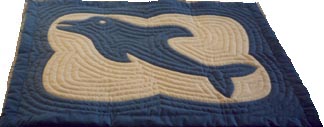


NEW SUPPLIES YOU WILL NEED
Hoops come in a multitude of sizes and for a variety of purposes,from tiny ones for embroidery to large ovals, too big for most people to handle. Most are made of wood although there a few newer, rectangular hoops made of PVC pipe. Preferences vary, you may want to try several. For quilting, the most generally useful and popular choice, is an adjustable 18 inch circle. These are available at all quilt supply stores,and many hobby/variety stores. Eventually you may want to consider buying a 1/2 hoop for the edges of your quilt but this is not essential and will be discussed again later.
There are also quilting frames, both homemade and commercial types. The drawback is that they can be quite expensive and take up considerable space. If interested, by all means investigate the possibiities, but most quilters use hoops.
Quilting Needles, for reasons only clear to the manufacturers, are called "Betweens". They come in sizes from 5-12; the larger the number, the smaller the needle. There are quilters with excellent eyesight who swear by size 12 needles, can see to thread them, and don't mind a good many broken needles. Most quilters use sizes 8 or 9 which work perfectly well and are much less fragile.
Quilting Thread: It is possible to buy 100% cotton quilting thread which some purists prefer, at many quilting supply shops. Coats Dual-Duty Hand Quilting thread, a cotton-wrapped polyester, is available almost everwhere, comes in a good variety of colors and produces excellent results.
Choosing a thread color or colors is again a matter of preference. Many, perhaps most, quilters use a single color of thread usually matching the background, throughout their quilts.
Others prefer using colors matched to the area being quilted, ie. one on the design and another on the background. Occasionally, as on a quilt with a very dark background and a lighter design, it may be desirable to use thread in the design color throughout. The choice of which approach to use may be limited by fabrics which no quilting thread will match.
Beeswax: If for any reason you didn't wax your thread while appliqueing, by all means get some wax and plan to do so now. Nobody can enjoy quilting with tangled threads.
Finger Protection: It is said, and truthfully, that no quilt is complete until it has been marked with the blood of its maker. To minimize damage two fingers need to be protected, the one with which you push your quilting needle -- either thumb or middle finger of hand with which you sew, and the one you keep under the quilt to guide the needle -- usually the index or middle finger of the opposite hand.
How to best do this is a never-ending topic and the market is flooded with thimbles and thumbles -- metal, leather, plastic and all sorts of combinations. Some quilters use protectors which they design themselves. Most quilters also keep a suply of band-aids on hand especially for use on the underneath fingers. It is impossible to make a recommendation other than just to experiment until you find something you like. Also, you will eventually develop "quilters' calluses".
Something loved by most quilters is an an ointment known as "Bag Balm". Originally developed for use on udder irritations in cows, it does wonders for sore fingers. Almost all quilting supply stores stock it, as of course do veterinary suppliers.
Markers: There are some people who can quilt in neat straight lines without marking. Most of us cannot. There are dozens of marking devices available, pens and pencils in a variety of types and colors. Never use one without testing it first on your fabric to be sure that it fades or washes out completely.
Basically markers come in two types. The first, colored chalks or pencils, are generally safe to use. They wash out easily and, if you make occasional mistakes in marking, can be erased with a soft fabric eraser. Two in particular, the "Quilters Silver Pencil" and any soft white chalk pencil are particularly useful. One or the other will show up well on almost any fabric color.
The second type is chemical markers. These are usually pens which make a blue or purple mark and are supposed to fade out automatically after a number of hours. Some do, some don't, and some fade partially leaving faint brown stains which remain forever. Results vary with both pen and fabric. If you use them be very sure to check first on a fabric scrap. One which does seem to live up to its claims is "Air Erasable Pen - Violet" which is sold at Wal-Mart and probably elsewhere. It makes a thin purple line which fades in 24-36 hours and which is removable with a damp cloth or sponge to correct marking errors. It can be quite useful on print fabrics.
Measuring Devices: The lucky people who can quilt without marking, often are able to do so without measuring the distance between rows of quilting. The rest of us need some help. Quilting rows are usually spaced 5/8ths to 3/4 inches apart. As with other supplies, a variety of measuring tools can be purchased.
One of the simplest and most effective is a cheap wooden ruler which already has marks at the appropriate spacings. Along the entire length of the ruler, using an indelible pen, deepen and re-mark the spacing you wish to use. You can even do 2 rulers in case you change your mind about spacing. This gives you a tool which not only can measure spacing between individual rows of quilting, but can also be placed within or between design sections to determine how many rows will be needed to fill the space.
READY, SET, GO
You are now fully equipped with everything you should need to finish your quilt. Now we move on to how you are going to use it.